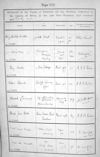|
Personal information about Albert Alexander
Below is all the information we have about Albert Alexander. As far as we know, the information is correct. However, if you find any errors or have additional information, certificates or pictures, please contact us so that we can update this page. Thank you.
Death Information
Name: |
|
Albert Alexander |

Death certificate for Albert Alexander
Certificate provided by FNRC
|
Death certificate for
Albert Alexander *
Click image to enlarge |
|
|
Maiden name: |
|
|
Date of Death: |
|
|
Age at death: |
|
44 |
Date of birth:
(From death certificate) |
|
|
Place of birth:
(From death certificate) |
|
|
Gender: |
|
Male
|
Place of death: |
|
Radcliffe Infirmary, Oxford, Oxford |
Usual address: |
|
|
Occupation: |
|
Police Constable |
Cause of death: |
|
perforated gastric ulcer
staphylococcal pyemia |
Death certificate information
|
Registration year: |
|
1941 |
Registration quarter: |
|
March
|
Registration district: |
|
Oxford |
Register volume: |
|
|
Register page/folio: |
|
|
|
| Comments: |
| Information Sources: General Register Office |
| This death record requires verifying. |
Burial Information
Name on burial register: |
|
Albert Alexander |
|
Burial register image
Click image to enlarge |
|
Age at death: |
|
44 |
Date of burial: |
|
19 March 1941 |
Abode at death:
(according to burial register) |
|
Radcliffe Infirmary, Oxford |
Burial register information: |
|
| Book number: |
1917 |
| Page number: |
232 |
| Record number: |
11452 |
|
Official at burial: |
|
A.A.H.Radice |
| |
|
|
Source of information: |
|
Burial Register |
Memorial Details
| |
Albert Alexander |
| |
15 March 1941 |
| |
44 |
| |
Male
|
| |
|
| |
Kerbstones with headstone at E end |
| |
Granite |
| |
|
| |
On headstone: In/Loving Memory of /Albert Alexander, / died March 15. 1941/ aged 44./ At rest./Edith Mary / Alexander/ his wife/ died October 10. 1985 / aged 89.//
|
| |
|
| |
Kerbstones with corner pillars and headstone at E end |
| |
Ch32 |
| |
|
| |
|
| |
01 September 2013 |
| |
HVR |
| |
| Click here for more information on this memorial. |
Other people list on this memorial
Obituaries and Newspaper announcements
| Albert Alexander |
|
| Article source: |
|
The National Association of Retired Police Officers |
| Date of source: |
|
01 January 2004 |
| Copyright: |
|
© as above |
|
|
|
Oxon NARPO* News - Spring 2004
Albert Alexander
During 1940 research was in progress on a drug known as penicillin. A number of experiments had been carried out on animals with some success and it was decided to risk a clinical trial. The team did not want to risk injecting a healthy volunteer in case of adverse reaction. It would be a constable from the Berkshire Constabulary.
Police Constable 231 Albert Alexander was a member of the Berkshire Constabulary. He was born in the parish of Woodley in February 1897, joined the Force in July 1921.
At the outbreak of the war he was stationed at Wootton and was a member of the Force’s Mutual Aid Team and was on standby duty to go anywhere in the Country.
At about 7 pm on 23 November 1940 men from the County were required to assist the Southampton police. Thirty men were mustered, one of whom was Constable Alexander. They reported to the Civic centre in Southampton. Upon their arrival there were sporadic raids, but the following week was comparatively quiet. Their time was spent on patrol and surveillance of damaged buildings.
At approximately 5:50 pm on 30 November a surprise attack came. A police station took a direct hit killing a sergeant and injuring two constables, one of whom was Constable Alexander. After treatment he was transferred to Abingdon Cottage Hospital where he developed blood poisoning. He was moved to the Radcliffe Infirmary Oxford for treatment. It was agreed that he would be injected with the drug penicillin. His condition improved as a result of the drug, but after 5 days the supply ran out and a month later he died. The problem of manufacture was taken up by the Americans.
The method they used to grow the cultures was in hundreds of BEDPANS.
* NAPRO is The National Association of Retired Police Officers. |
|
This obituary entry is awaiting verification.
|
|
|
| |
|
| DEATH OF P.C. ALEXANDER |
|
| Article source: |
|
Newbury Weekly News |
| Date of source: |
|
|
| Copyright: |
|
© Newbury Weekly News |
|
|
|
DEATH OF P.C. ALEXANDER
FUNERAL AT NEWBURY
His many friends in the Newbury District will learn of the death of Police Constable Albert Alexander, which occurred on Saturday in a hospital at Oxford. P.C. Alexander, who was only 44 years of age, had been ill for the past few months following special duty in a “blitzed” town. He was stationed for a number of years at Hungerford, Newbury and Brimpton, being transferred four years ago to Wootton in the Abingdon Division, where he was stationed at the time of his death. He had twenty years service in the Berkshire Constabulary and was a most popular officer.. P.C. Alexander leaves a widow and two children, with whom the utmost sympathy is felt.
Police officers from all parts of the County attended the funeral, which took place yesterday (Wednesday) at the Newtown-road Cemetery, Newbury, where a service was conducted by the Rev. A.A.H. Radice.
The family mourners were: the widow, Mr. and Mrs. Alexander (brother and sister-in-law), Mr. And Mrs. G. Annetts (sister and brother-in-law), Mrs. E. Annetts (sister), Mr and Mrs Daws (sister and brother-in-law), Mrs. Lucas, Mrs. Hughes sisters-in-law, Mr. Deacon (brother-in-law), Mrs Crawshaw, Miss Crawshaw, Mr. Bowley.
There were also present: Supt Crombie, Reading (representing the Chief Constable), Supt Barrett (Abingdon) Supt. Lambourn (Newbury), Inspector Bennett (Newbury), Inspector Burbidge (Faringdon), Inspector East (Wokingham), Inspector Hayter (Abingdon), Inspector Haskins (Maidenhead), Inspector Lidsey (Didcot), Sixteen police sergeants and 54 constables attended in addition to Section Officer Hough and three special constables from Cumnor.
Wreaths were sent from his wife and children; Sheila and Brian; Daisy, Gwen and Jack; Gran; Nin, Whoop and Humphrey; Sid Kit and Monica; Neil, Mabel, Joe, Dorrie and Harry; Peggy and Fred; Eve and George (Shinfield), and Ted and Neil (Burghfield); Phil, Daisy and family;All at Homer Cottage; Four Neighbours; Friends at “The Bystander”; Mr. Trinder, Edith and Margery; Mr. and Mrs. Sayer and Ken; Mr. and Mrs. Binning and family; Inspector and Mrs Huckins;Mr. And Mrs. G. Tomkins; Mr. and Mrs. Moreton and John; Mr. and Mrs Meadows and family; Mr. and Mrs. Buzzard and family;Mr. And Mrs. Rowse and family; Mr. and Mrs. G.S. Gooden; Mr. and Mrs. Wing, Cumnor Post Office,Mr. And Mrs. Brewer and family; Children and teachers of Dry Sanden School; Home Guards of Wootton-road; White Hill Dairy; Air Raid Wardens, Lower Wootton; Chief Constable, Officers and Constables of the Berkshire Constabulary; Officers and Constables of the Newbury Division; Cumnor Police and Special Constables; Comrades of the Abingdon Division; Officers and Constables of the Maidenhead Division; Officers and Constables of the Wokingham Division.
FOOTNOTE:
Since the inclusion on our website of details of P.C. Alexander’s death we have been contacted by the following international institutions seeking further assistance.
1. MUSEU DO UNIVERSO DA FARMACIA, BRAZIL
Working on a mini-documentary about the history of penicillin
2. SCIENCE MUSEUM, LONDON
Working alongside India’s National Council of Science Museums in setting up an exhibition to tour India and three other countries. Funding is by The Wellcome Trust.
Also inclusion in the public exhibition at the Science Museum, Kensington, in the Wellcome Gallery.
3. THE CENTER FOR EDUCATIONAL TECHNOLOGY, ISRAEL
Developing an online educational course in microbiology for high school students in both Hebrew and Arabic.
4. JEFFREY BIOMEDICAL RESEARCH CENTRE, CAMBRIDGE
Setting up a free online educational exhibition around the history of scientific tools, etc. hosted by WhatisBiotechnology.org, a charitable educational resource.
Gratifying isn’t it!
|
|
|
|
|
| |
|
| Albert Alexander |
|
| Article source: |
|
Paul Thompson |
| Date of source: |
|
01 March 2020 |
| Copyright: |
|
© FNRC |
|
|
|
NOTE:
WELLCOME GALLERY, SCIENCE MUSEUM
You may be aware that toward the end of last year, we were contacted by the London Science Museum about Albert Alexander (the first person in the UK to receive experimental penicillin treatment) who is buried in the cemetery. They were planning a large display on medicines and had seen our material on Albert and wanted to use some of it in a special display on penicillin as part of the exhibition. We agreed and liaised with Albert’s family for the use of the photographs that we have on site by kind permission.
I am pleased to say that the exhibition is now open in the “Wellcome Gallery” and I have recently been to see it. Albert’s is a small part of the display, but he played a major role in the development of penicillin and we are proud to have played our part helping to create this interesting exhibition. Admission to the Science Museum is still free if you are up that way. |
|
This obituary entry is awaiting verification.
|
|
|
| |
|
| Albert Alexander |
|
| Article source: |
|
“One Hundred Years - Berkshire Constabulary: 1856 - 1956” Sgt. Bill Indge |
| Date of source: |
|
01 January 1956 |
| Copyright: |
|
© as above |
|
|
|
ALBERT ALEXANDER
From: “One Hundred Years - Berkshire Constabulary: 1856 - 1956”
The use of the aeroplane since the first World War had altered the whole complexion of enemy activity and it was no longer a case of sending as many men as could be spared abroad as the needs of the Home Front were infinitely more exacting. Concentrated attacks on cities and towns meant the normal police requirements were totally inadequate to deal with the situation, and the Mutual Aid Scheme was brought up to date.
Selected men throughout the Force were warned that they might well be required to move anywhere in the country, with as little as perhaps one hour’s notice, and so it was that at about 7 p.m. on November 23rd, 1940, men from Berkshire were required to assist the Southampton police.
Ten men from each of the divisions of Abingdon, Newbury and Wantage, under INSPECTOR BENSTEAD and SERGEANT SHUFF reported to the Civic Centre. On their arrival, there was sporadic bombing, but the following week was completely quiet. The time was spent on general patrol and the surveillance of damaged buildings.
At approximately 5.50 p.m. on November 30th, 1940, the town had not then emptied of shoppers, and without any warning provided by the siren, the whole town was brilliantly illuminated with curtains of flares. Soon afterwards thousands of incendiary bombs were literally showered down, and there was soon a blazing inferno. Shelters were quickly filled but many of the public were caught unawares.
That evening SERGEANT SHUFF, accompanied by a member of the Southampton force, was leaving the parade room when the building was struck. The sergeant took the main force of the blast travelling along a passageway and was killed. His colleague, within touching distance, was unhurt. P.C. HALL received a broken leg and P.C. ALEXANDER received injuries which, together with an infection, brought about his death later.
Many are the stories told by the men who went to Southampton, but no amount of recapitulation will do justice to the duty that was so unflinchingly performed.
...
|
|
|
This obituary entry is awaiting verification.
|
|
|
| |
|
| 1939 census |
|
| Article source: |
|
1939 census |
| Date of source: |
|
|
| Copyright: |
|
© |
|
|
|
Shows Albert and his family living at
17 Cumnor Road, Abingdon.
See photos of entry below |
|
This obituary entry is awaiting verification.
|
|
|
| |
|
| GOTM Albert Alexander FONRC |
|
| Article source: |
|
FONRC |
| Date of source: |
|
08 July 2023 |
| Copyright: |
|
© |
|
|
|
Grave of the Month - Albert Alexander
The grave of the month for July just has to be Albert Alexander!
Constable Albert Alexander had been posted to Southampton in 1941 to assist the local police after a period of bombing. The police station took a direct hit, killing a sergeant and injuring two constables, one of whom was Albert.
After treatment he was transferred to Abingdon Cottage Hospital where he developed blood poisoning. He was moved to the Radcliffe Infirmary Oxford for treatment. It was agreed that he would be injected with the drug penicillin. His condition improved as a result of the drug, but after 5 days the supply ran out and a month later, he died on the 15th March 1941 and was buried in NRC on the 19th March 1941.
Newtown Road Cemetery received a visit on the 29th of June from his daughter Sheila LeBlanc and his granddaughters Linda Willison and Karen LeBlanc who had all flown from California specially for this event, to view the blue plaque in Carnarvon Place to Albert’s memory and to attend as guests the World Congress of Pharmacology in Glasgow.
The Mayor and Mayoress, Nigel Foot and Sarah Slack, Thames Valley Police A/Chief Inspector, Andrew Hunt and Professor Mike Barrett from Glasgow University attended together with Dave Stubbs and various Friends of the cemetery. The event was covered by the BBC, NWN and several other photographers.
Sheila LeBlanc, who was 8, when her father died in 1941, laid flowers on her father’s grave.
Brian Sylvester presented Sheila with a miniature set of her father’s war medals.
Karen LeBlanc, Linda Willison and Sheila LeBlanc at Albert Alexanders graveside. Left to right. |
|
This obituary entry is awaiting verification.
|
|
|
| |
|
| True story of penicillin’s first patient |
|
| Article source: |
|
Bill Sullivan |
| Date of source: |
|
17 April 2022 |
| Copyright: |
|
© Bill Sullivan |
|
|
|
Here’s the true story of penicillin’s first patient
By Bill Sullivan
April 17, 2022
Albert Alexander was dying. World War II was raging, and this police officer of the county of Oxford, England, had developed a severe case of sepsis after a cut on his face became badly infected. His blood was now teeming with deadly bacteria.
According to his physician, Charles Fletcher, Alexander was in tremendous pain, “desperately and pathetically ill.” The bacterial infection was eating him alive: He’d already lost one eye and had oozing abscesses all over his face and in his lungs.
Courtesy of Linda Willason, CC BY-ND
Albert Alexander in uniform.
Since all known treatment options were exhausted and death appeared imminent, Fletcher decided that Alexander was the perfect candidate to try a new, experimental therapy. On Feb. 12, 1941, Alexander became the first known person to be treated with penicillin. Within days he began to make a stunning recovery.
I am a professor of pharmacology, and Alexander’s story is the prelude to my yearly lecture on antibiotics. Like many other microbiology instructors, I’d always told students that Alexander’s septicemia arose after he scratched his cheek on a thorn while pruning rosebushes. This popular account dominates the scientific literature as well as recent articles and books.
The problem is, while descriptions of the miraculous effect of penicillin in this case are accurate, the details of Alexander’s injury were muddled, likely by wartime propaganda. |
|
This obituary entry is awaiting verification.
|
|
|
| |
|
Pictures and photographs
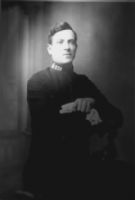
Albert Alexander
©with permission of the Sir William Dunn School of Pathology
Albert Alexander
|

Albert Alexander
©with permission of the Sir William Dunn School of Pathology
Albert Alexander
|

Albert Alexander
Albert in his Police uniform (top left)
©Linda Leblanc
Albert Alexander
|

Edith Alexander
Albert's wife Edith with Sheila
©Linda Leblanc
Edith Alexander
|

Albert Alexander
Oxfordshire Blue Plaque sited at The Radcliffe Infirmary, Oxford
©Oxfordshire Bolue Plaques Board
Albert Alexander
|
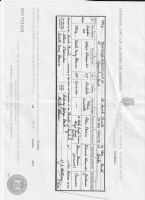
Albert Alexander
copy of marriage certificate - Albert Alexander and Edith Deacon
©General Register Office
Albert Alexander
|
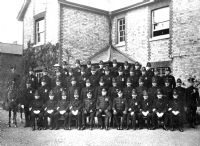
Albert Alexander
taken on or around 31st March, 1925 at the retirement of Superintendent Joseph Maunders (centre) after 38 years service.
© kindly provided by David Stubbs - Albert Alexander is towards the back on the left-hand side between the window and the mounted officer.
Albert Alexander
|

Albert Alexander 1939 c
Albert Alexander 1939 c
|
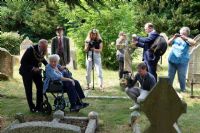
Sheila LeBlanc Albert's daughter visiting 29/06/2023
Sheila LeBlanc Albert's daughter visiting 29/06/2023
|

Karen LeBlanc, Linda Willason (Granddaughters), Sheila LeBlanc (daughter) visiting grave of Albert Alexander 29/06/2023 from California
Karen LeBlanc, Linda Willason (Granddaughters), Sheila LeBlanc (daughter) visiting grave of Albert Alexander 29/06/2023 from California
|
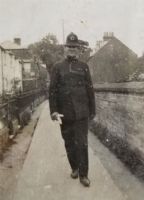
Albert Alexander in Police Uniform
©Linda Willason
Albert Alexander in Police Uniform
|
.JPG)
Albert Alexander grave
©fnrc
Albert Alexander grave
|
Biographies & History
Related Links
These links go to other websites with information that is relevant to this person.
Please note that FNRC is not responsible for external web site content.
*The FNRC believe that the certificates published on this page have been added in compliance with the rules laid down by the General Register Office (GRO).Click here for more information.
If you believe that we may have inadvertently breached the privacy of a living person by publishing any document, pleasecontact usso we can immediately remove the certificate and investigate further.
Thank you
FNRC.
|
Website designed and maintained by Paul Thompson on behalf of the Friends of Newtown Road Cemetery.

Administrator Login
|
|



